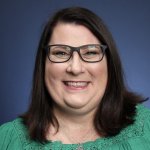In this episode, behavior specialist Angela Isenberg, and guest specialist Melinda Marquez, talk about creating a positive school culture and climate for your campuses and schools.
Download the full transcript of this week’s episode.
Angela :
Welcome to I’ve Tried Everything, a podcast series focusing on behavior support in schools. I’m your host, Angela Isenberg. I’m the program manager for behavior here at the service center. Our special guest for the series is Melinda Marquez.
Melinda:
Hi, Angela. Behavior is such a hot topic, especially for campus leaders. When I was a principal I was always looking for guidance around behavior. You know, I think the name of this podcast is great because in fact I felt like I did try everything.
Angela :
Our goal with this series is to provide strategies and guidance for campus leaders on how to best support their campus on behavior. We will be sharing insights, our experiences, and the things we learned along the way.
Melinda:
So step away from your email, grab that last cup of coffee and let’s get started.
Angela :
This podcast series is all about creating a positive school culture and climate. When looking at your positive school culture and climate, it ties directly into what we’ve already talked about throughout this series of creating those multi-tiered systems of support with positive behavior, restorative practices, helping teachers with classroom management, and how to appropriately redirect student behavior. Melinda, when you think about positive school culture and climate as a principal on the campus, what are some things that you kept reviewing and looking back at to develop that?
Melinda:
You know, one of the most important things is your vision, mission, values, and the goals for your campus. And I don’t think people really understand quite how important those things are. When you think about that Simon Sinek, your Why, your mission and your vision is really your Why. It allows you all to be headed in the, in the same direction.
Angela :
From that Simon Sinek Why, if you think about the golden circle that he has drawn in his TED talks, is that we can talk a lot about what we do and how we do it, but we’re not really effective on why we do what we do. And we can say, yeah, we educate students, but there’s more to it. When we think about getting into the profession of teaching, we didn’t get into the profession of teaching for the money and the claims that, you know, the being famous. We got into teaching because we love children. And really bringing it back to how do we create a climate on your campus that students can’t wait to get to every day. Not only excited, but feeling safe emotionally, physically, psychologically, and, and they want to be there.
Melinda:
Right. And you know each campus is different even though, you know what you just said, Angela, is the underlying meaning behind those visions and missions. But really for your campus, what is the vision for your campus? What’s the mission for your campus and your kiddos? So it’s so important whenever those missions and visions are created, that you have that stakeholder input.
Bring students in, bring parents in, bring community members in. Of course, your staff and your administrative team. We’ve seen so many of those campus missions and visions that kind of are there, but they’re never revisited. People aren’t sure what they are. They know that they may be on letterhead somewhere or it’s maybe listed on the website. But it’s not really something that people know and it’s not integrated into their campus.
Angela :
And I think those mission, visions goals translate into high expectations and having high expectations for not only your students but your staff, and really thinking through how are we going to make sure that we get people to the next level. That good to great idea. And for me as a high school teacher, I always thought about how do I want to make sure that I’m in embedding the values, the beliefs, the things that are going to make these students productive members of our society.
And when I talk to elementary campuses, I think about what do these students need? How do we have high expectations for them so that when they go to middle school they have a successful transition to middle school. They have more ownership of their learning. They have more ownership of their behavior as they’re moving throughout that educational system. So how do, Melinda, how do we create a shared ownership for student success?
Melinda:
You know, I think it’s those high expectations, setting those high expectations for everyone on campus. You know when I go out to campuses now in my role, I ask campus principals, how do you ensure that your staff has high expectations for students? And it doesn’t fail, every single time I ask a group of administrators or teachers that there’s silence in the room as they’re trying to figure out, do we do that? What does that look like? We know we have high expectations, but how are we getting that information to students? How do students know that we have high expectations for them?
I was at a campus recently and everywhere they have college banners. There’s college pennants in the cafeteria. Outside of the doors the teachers show where they went to college. They have college fairs. Just the names of colleges are embedded all across the campus. But what they found out is that students didn’t realize that those weren’t just decorations. The students had no idea that teachers had high expectations that those students would go to college or have a career after they got of high school. And so they had to actually say those words to the students even though their whole school had all of the college information listed everywhere. But unless you specifically say it to the students, Hey, we expect this from you. We expect that you’re going to go to college. We expect that you’re going to have a career after high school. So it’s really being really specific with those expectations.
Angela :
It’s that connectedness and then making sure that what we do and say are all connected together, and it’s genuine and authentic. I think about a campus that I’ve visited and when the bell rang for passing period, every teacher was at the door shaking kids’ hands as they entered. It looked impressive. No matter what hallway we went on that’s what we saw. And I had an opportunity that day to talk to students. I brought in a group of students and I asked them, how do you guys feel about being greeted with a handshake whenever you come into the room? And they say, Oh, it’s okay. And I said, what do you mean? Oh, it’s okay. And they said, well, we think the principal just told them they had to do that. And I said, wow.
And so I said, tell me some more about this. So two gentleman’s names kept coming up and I said, what is it about these two teachers? And they said, well, when they shake our hand, they look us in the eye and they say our name. And I was like, wow. I mean these students knew what a genuine handshake was. They knew when it was just like a rote kind of just I’m going to shake everybody’s hand. It’s that connectedness. It’s not just the act of doing something. It is genuinely and authentically doing what it is, and that practice to create those opportunities for high expectations, ownership, and a shared vision across campus.
Melinda:
And that’s why it’s so important to have those teachers in those meetings and the vision and mission to be revisited every single year. Because I know that people, beginning of the year it’s hard to get everyone because everybody’s trying to figure out beginning of year procedures. But really revisiting your campus vision and mission are going to be high on that list to ensure that your campuses have that, have everyone heading in the same direction.
I’m Melinda Marquez and we’ll get back to today’s episode in just a second. If you like what you hear in this episode, hop on over to whatever platform you use and give us a rating and a review. It helps people find our podcast and helps us know what we can improve upon. Thanks. Now let’s get back to the show.
Angela :
I know that surveys are a way to assess whether or not you have launched into that, truly embedding those practices into everyday life. What are some recommendations that you would advise for principals on surveying your staff or students?
Melinda:
You know, one of the biggest things about surveys is the question of what are you going to do with the results? I’ve been to campuses where they survey, they survey, they survey. But really it’s almost like a compliance. A district told the campus they had to survey so they survey, but it’s that next step that’s going to be the most important. And it’s always you have the data, now what? Now what are you going to do about it? When you get your voices heard, when you get the voices heard of the staff and the students, changes have to happen based on those results or maybe nothing has to happen because the real results look great. But as long as the campus, the students and the staff know that you are surveying for a reason and their voices are going to be heard, that’s the most powerful use of campus surveys.
Angela :
Would you recommend campuses survey parents?
Melinda:
Oh absolutely. That’s another piece to that. You know you want to hear from your parents, and it’s scary. As a campus principal, giving a survey is one of the scariest things you can do, because you know that as much as you’ve tried to cover all your bases, you’re going to have people who just aren’t seeing things the way you’re seeing them. And it’s okay that that happens as long as you know that. And if you’re able to address those concerns, then you’re going to be fine.
Angela :
So really what you’re telling me, Melinda, is if I have a clear mission vision and focus for the campus. I really think through having high expectations and a shared ownership and that we’ve embedded that, and we’ve reflected on it. We’ve taught staff that, and then we’ve used it in our language, our approach with students and staff. And then we’ve surveyed to see where we’re at. Would that get us to where we want to go with positive school culture and climate?
Melinda:
I think it’s a great start. Absolutely. You know all the other things we’ve been talking about in this podcast really tie in to this. That’s maybe the what and the how to get to a positive school culture.
think it’s a great start. Absolutely. You know all the other things we’ve been talking about in this podcast really tie in to this. That’s maybe the what and the how to get to a positive school culture.
Angela :
If I wanted to learn more about positive school culture and climate, are there things that you do here at the service center that helps support folks?
Melinda:
We do. We have trainings on the effective schools framework. You know, positive school culture is the prioritized lever three. There’s a lot of districts and campuses out there who are highly involved in the effect of schools framework. So they know all about lever three and the different levers. But we do a full day training on the effective schools framework. The affective schools framework is really just a statewide vision on best practices. There’s nothing in this framework that somebody would look at and say, “Oh my goodness, that is amazing. I’ve never thought of that.” These are just evidence-based best practices in an organized manner.
Angela :
Wow. It’s great that there’s a guide now for people to kind of look back and say, “Are we on the right track? Are we doing what we need to do?” instead of trying to piecemeal things together along the way. So I’m interested to learn more about this effective schools framework. So hopefully you branch off and do some podcasts around that because I would love to hear more about that.
Melinda:
That sounds like a good idea.
Angela :
Well, thank you guys very much for joining us in this series of I’ve Tried Everything. I’m your host, Angela Isenberg.
Melinda:
And I’m Melinda Marquez.
Angela :
And we thank you so much for joining us and being on this venture through our podcast series of I’ve Tried Everything.
Melinda:
If you like what you’ve heard, don’t forget to subscribe, rate, and review us.
Angela :
Have a great day.
Angela has 24 years of experience in education. She has been in her current position for 12 years. Angela has trained and provided coaching support to over 200 campuses for PBIS. She is also a certified Restorative Practices coordinator. She is a trainer for Interventions, Coaching Classroom Management, CHAMPS, and Why Try.






Add comment